Driving to Alaska is an epic adventure and is one of the most beautiful road trips you can take in North America.
We spent several weeks this summer driving to and from Alaska, as well as spending more than a month up there. We published a guide all about the two different routes we took, where we stayed, what we did each day, etc., but I also wanted to publish this separate post giving lots of tips and tricks in case you’re planning on making this journey for yourself.
From safety to logistics to preparation and more, here are 21 tips and tricks for driving to Alaska.

1) Get Your Car A Tune-Up
No matter where in the US you start your road trip up to Alaska, you’re looking at driving at least 2,000 miles each way. That can be heavy going on your car, especially considering the condition of some of the roads you’ll encounter, so before setting off it’s worth getting a tune-up. Get an oil change, check your tires and brakes, etc. to minimize the chance that your car will have issues in the middle of nowhere.
2) Check Google Travel & Booking.com For Accommodation
We’ve been living in hotels and Airbnbs for almost seven years on our 50 state road trip, so I’m very familiar with researching accommodation options as we travel around the country.
Driving to Alaska is a different beast though. For much of the drive through British Columbia and the Yukon you won’t find any chain hotels. There’s also a limited number of independent hotels and motels that you’ll find listed on OTAs (Online Travel Agencies) like Hotels.com, Expedia, etc. If you’re traveling in a car or on a motorbike rather than in an RV, that can make it harder to find somewhere to stay for the night along the route.
What I discovered while looking into our accommodation options is that there are a couple of sites that show a wider selection of hotels and motels than other mainstream OTAs do – Google Travel and Booking.com (our affiliate link). Google Travel in particular would often show a substantial number of small motels and bed & breakfasts that simply weren’t listed elsewhere. Sometimes those accommodations would have their own website where you find out more details, see pricing, etc., but other times there was simply only a phone number as those motels had no other web presence. This helped us find somewhere to stay at least 2-3 times on our drive, thereby providing more economical and/or convenient stopping places for the night.
For example, on Google Travel there’s almost a dozen different booking options for Dease Lake in British Columbia, whereas Hotels.com had zero.

3) Refuel Frequently
Several years ago, Shae read a book by British comedian Dave Gorman called America Unchained (our affiliate link). Gorman went on a road trip around the US, only using non-chain services. No chain restaurants, no chain hotels, etc.
One of the trickiest parts of his journey was finding somewhere to fill up his car with gas as he couldn’t use chain gas stations. He therefore had an approach he referred to as ‘battleship tactics’. Anytime he saw a gas station that wasn’t a chain, he’d refuel. Even if he had more than half a tank left, he wasn’t sure when he’d next reach a non-chain gas station and so he’d fill up.
We had a somewhat similar approach for our drive up to Alaska. If we were at about half a tank and we were passing a gas station, we tended to stop to fill up unless we knew for sure that there would be gas stations available a little later on that day (perhaps because we’d be driving through a larger town). This gave us peace of mind that we weren’t ever at risk of running out of gas, plus it gave us an opportunity to stretch our legs more frequently than we might have otherwise.
4) Download Offline Maps
This might be a tip I should’ve listed first because, for me, it’s perhaps the most important tip of all of these. For much of the drive through Canada you won’t have any cell phone service, no matter which carrier you’re with. That means Google Maps won’t be able to provide directions if that’s the service you’re relying on to get from one place to another.
Thankfully Google Maps has a feature that allows you to download offline maps. Even if you have no signal, you can type in anywhere located within the map(s) you’ve downloaded and get step-by-step directions. If you’re directionally challenged like me, that can be extremely helpful.
I’d written a post about this a few years ago, so check this out for instructions. You can only download so much of an area for any given map, but you can download numerous different areas in order to cover your entire route up to Alaska.
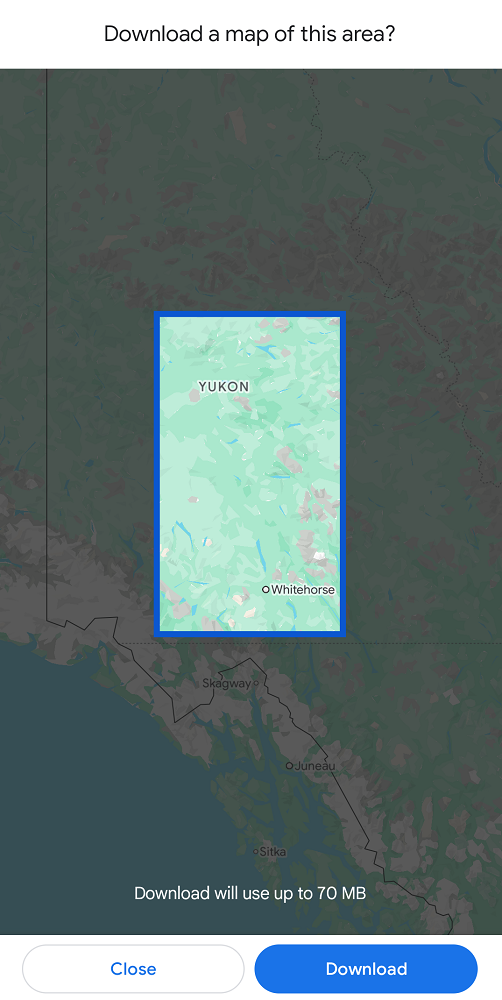
5) Have Credit Cards With No Foreign Transaction Fee
If you’re making the drive up to Alaska from the US, the majority of your journey will have you driving through Canada. That means that anything you buy along the way will be priced in Canadian dollars.
If you’re paying with a credit or debit card, you might find yourself incurring a ~3% foreign transaction fee on each transaction which can quickly add up. There are many credit cards out there that don’t charge a foreign transaction fee though, so it’s worth checking each of the cards you might want to use during your trip and only using those that won’t charge you more for using it in Canada.
6) Bring Provisions
Depending on how long you end up driving each day, you might find yourself getting to your overnight stop in the evening or late at night. Depending on the size of the town where you’re staying, you might find that there aren’t any stores or restaurants open when you arrive. It’s therefore worth having a stash of easy-to-make meals in the event you need them. Ramen noodles, mac n’ cheese, microwaveable soup bowls, etc. – these can all be good backup options.
You might also have limited options for somewhere to stop for lunch along the way too. We therefore had tuna packets, tortilla wraps, chips, fruit, turkey sticks, nuts, etc. to snack on when needed.
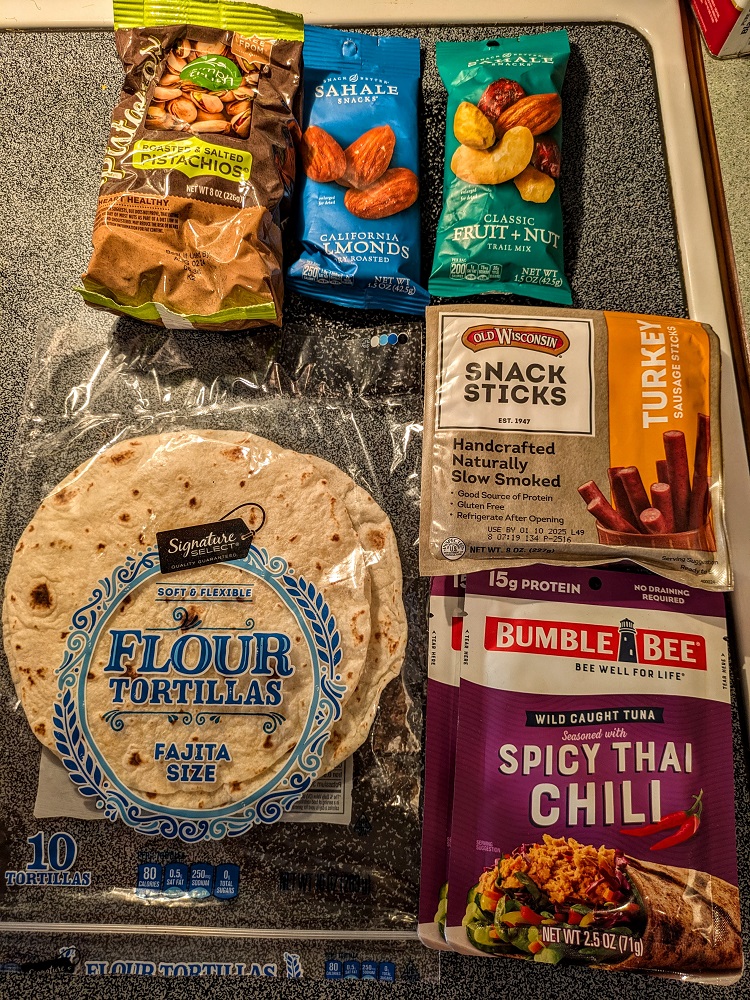
7) Longer Daylight Driving Hours
Where possible, we try to avoid driving long distances at night time, especially in areas where we’re more likely to encounter wildlife like deer, elk, moose, etc. One of the nice things about driving up to Alaska is that as you get further north, the number of daylight hours greatly increases. That gives you an opportunity to drive much further distances each day if you’d rather avoid driving after sunset.
8) Know How Many Liters Are In A Gallon
Canada uses the metric system, so when filling up with gas you’ll see prices by the liter rather than by the gallon. At some gas stations along the Alaska Highway you can fill up with gas first, then go inside to pay.
Other times though, you have to pay first and then refuel. That can make it tricky knowing how much money to have them put on your pump, so it’s worth being aware of the fact that there are 3.79 liters in a gallon.
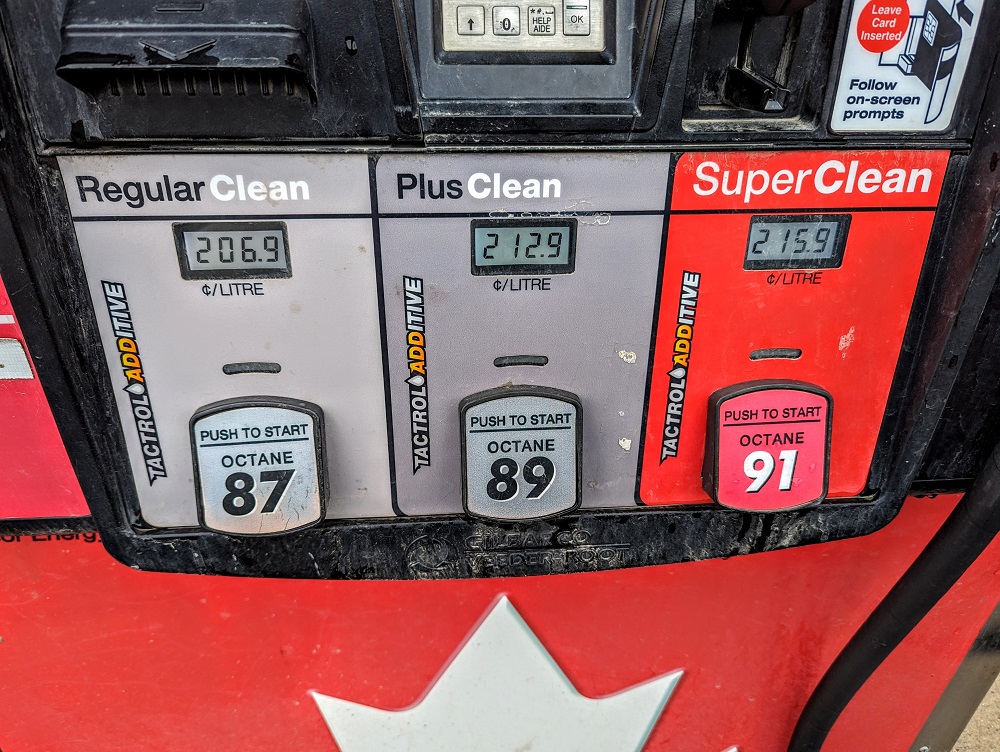
9) Register For Petro-Points Rewards
Speaking of gas, the most common gas station chain we saw along the drive was Petro-Canada. They have a loyalty program called Petro-Points Rewards that rewards you for filling up with gas, buying snacks in-store, etc. It’s worth registering for the loyalty program as you’ll be filling up with fuel frequently along the drive.
We racked up a $12 discount by the end of our journey back down from Alaska. That’s not a massive amount, but it’s savings we got for very little effort. We were driving our 2004 Toyota Corolla which had pretty good MPG, so if you’re driving a truck or RV that sucks up the gas much more quickly, your savings could be far more substantial.
Bonus tip: when first registering your account, it’s worth taking a screenshot of your membership card with its barcode. You can view that barcode when opening their app, but for much of your journey it won’t load as you won’t have any signal. Having a screenshot means you can go inside and have them scan the card for rewards before you refuel.
10) Research Route Options By Selecting Date Of Travel
If you’re like me, you’ll do quite a lot of research on which route(s) to take before your drive up to Alaska. If you also use Google Maps like I do, you might need to change the date of your route search depending on when you’re researching your route options.
The reason why is that some roads you might want to take are closed for many months of the year. For example, we drove up to Dawson City in the Yukon so that we could do the Sourtoe Cocktail. From there, we drove on to Fairbanks, AK via Tok. If I’d looked at our route options in December, this is what I would’ve seen:
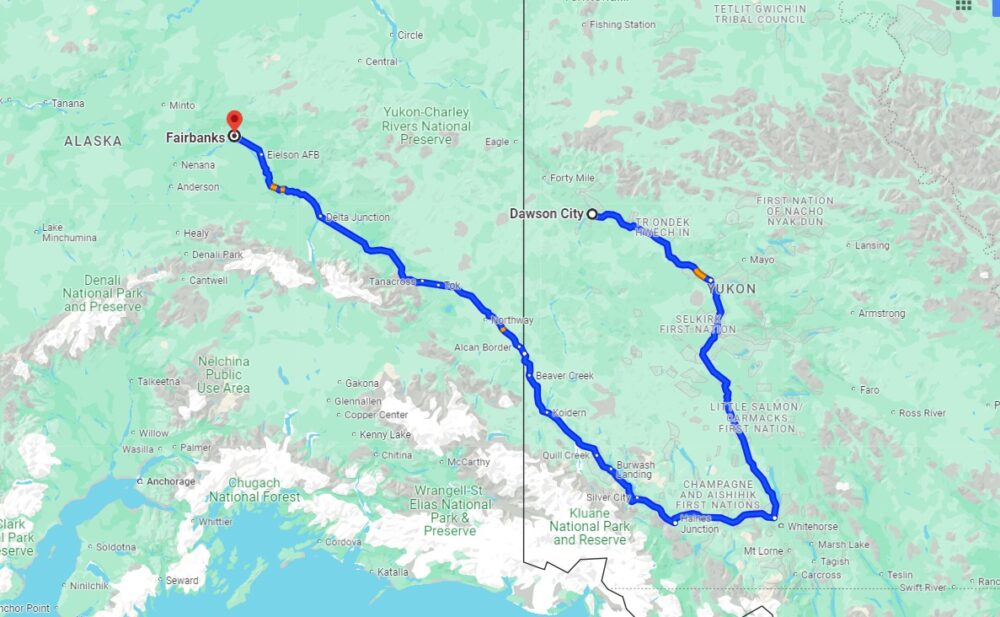
That’s a very roundabout way of getting to Fairbanks which is a 16-17 hour drive. If you’re making the journey in the summer though, you’ll have additional route options. That’s because the Top of the World Highway is open from May to September, slashing that 16-17 hour drive in half.

It’s easy to change your expected travel date(s) in Google Maps. When entering your start and end points, you’ll see a dropdown option saying ‘Leave Now’. Change that to ‘Depart At’ or ‘Arrive By’ and change the date.
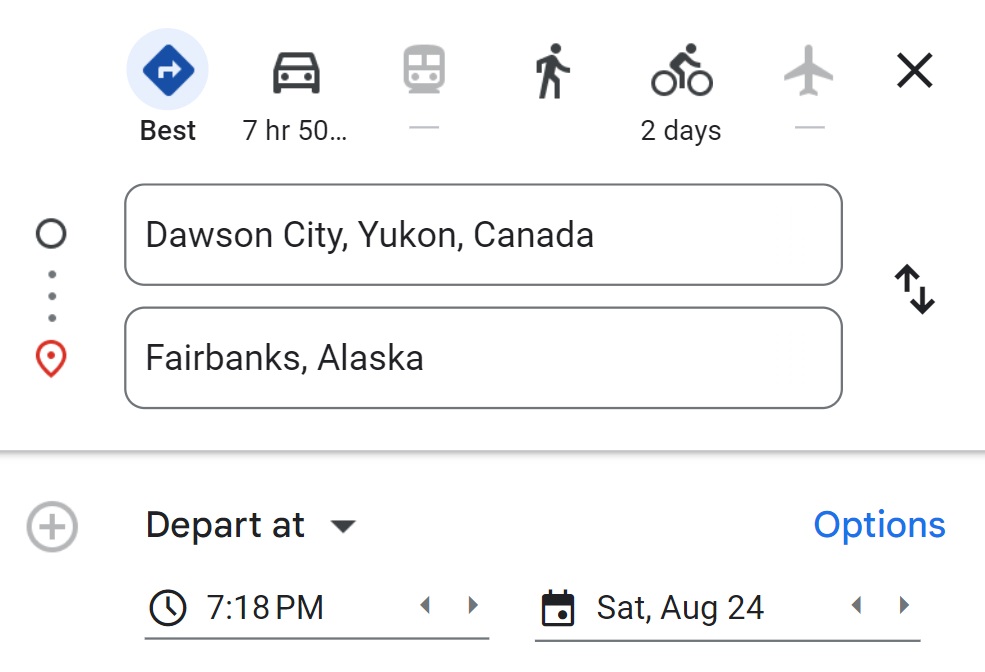
One slight frustration with this functionality is that when setting a different travel date, you can only enter an originating city and a destination city – you can’t specify stops along the way. If you’re wanting to research how to get from Point A to Point E at a certain time of the year with stops at Points B, C, and D along the way, you’d have to do separate searches for Point A to B, Point B to C, etc.
11) Stay More Than One Night Somewhere
There are lots of cool towns and interesting things to do as you drive up through British Columbia and the Yukon, so if you have enough time for your journey it’s worth spending a little more time in some of these places than just having a quick overnight stop.
12) Enjoy Some Sights Along The Way
In a similar vein, be sure to stop and enjoy some of the sights along the way. On the one hand I’m someone who likes to get from A to B as quickly as possible, but the drive to Alaska begs you to stop and spend time enjoying places along the journey. Make a stop at the Sign Post Forest (and bring your own sign to add to the ~100,000 signs there), have a picnic by a lake, check out the Heritage Park in Vanderhoof, go on a super quick hike to see Rancheria Falls, make a pitstop in Chicken, AK, etc.
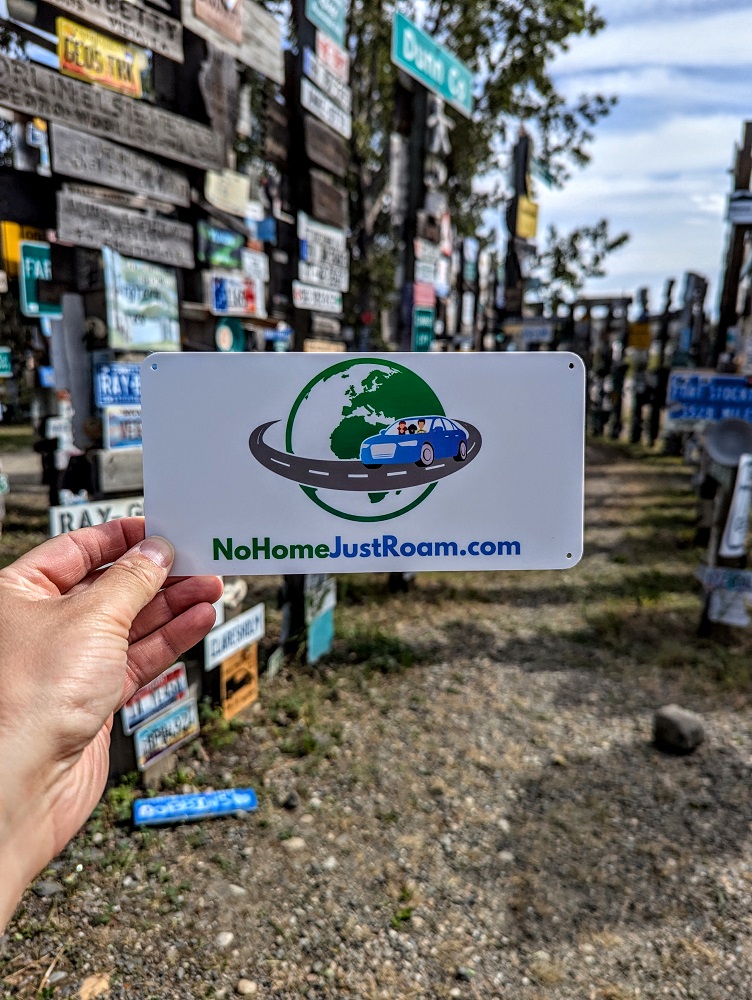
13) Have Toilet Paper & Soap/Hand Sanitizer With You
We were pleasantly surprised by how many rest areas with vault toilets there were as we drove up through Canada to Alaska. Nearly every one we stopped at was well stocked with toilet paper, but there were one or two that didn’t, so it’s worth having some with you.
Very few – if any – had hand sanitizer, so make sure you have that along for the ride too. We had a gallon-sized water bottle in our car in addition to our regular water bottles, so we used that with a small bar of soap to properly wash our hands when needed.
14) Clean Your Windshield Regularly
I recommended earlier that you stop to fill up with gas frequently. When doing so, also take advantage of the opportunity to clean your windshield as the drive can be very buggy at times.
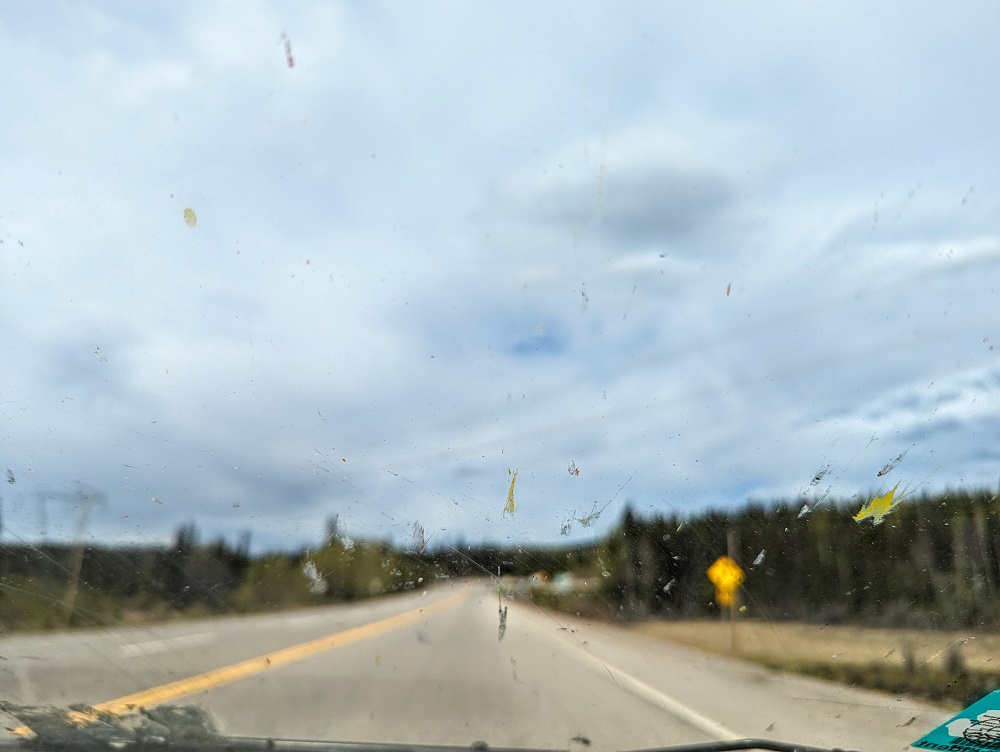
15) Make Refundable Bookings
If you’ll be staying in hotels, motels and Airbnbs on your drive to Alaska, try to book a refundable rate where possible if it doesn’t make the cost significantly more expensive. Weather, car trouble, etc. could interrupt your plans, so having a bit of flexibility can be helpful. We ended up rejigging our plans a few times before our drive up and drive back, so it was nice that we weren’t locked in to our original plans.
16) Stay Aware Of Forest Fires
Another reason that it can be worth having some flexibility with your plans is due to the risk of forest fires in Canada during the summer. They seem to have become even more prevalent in recent years and have the potential to affect your plans.
For our journey up to Alaska, we’d originally planned to route up via Fort Nelson and then through Watson Lake. A week or two before we made that drive though, Fort Nelson was evacuated due to forest fires in the area. We weren’t sure how long that would be an issue for, but a few days before we were due to stay the evacuation was still in place. We therefore cancelled our stay in Fort Nelson and routed via New Hazelton and Jade City instead.
Keep an eye on Canadian news for information about forest fires. Google Maps also seemed to highlight areas with forest fires when we were in the general area. On our drive back down from Alaska we saw some forest fires in the distance too, but thankfully they were far enough away to not affect our route that day.

17) Keep An Eye Out For Animals
We saw all kinds of wildlife when driving to Alaska, so keep an eye out for animals as you drive along. Both from a safety perspective, but also for the fun of seeing critters. While some animals like bears and moose are easier to see, Shae’s eagle eyes also helped us spot smaller animals like porcupines.
18) Bring Bear Spray
If you’re going to be doing any kind of hiking once you reach Alaska, you’ll want to have bear spray with you. It’s worth having some on the drive through Canada too just in case you stop places for lunch where bears could potentially be wandering.
Canada is OK with you entering the country with bear spray, but it has to be bear spray that’s specifically for protection against bears. My understanding is that you’re not allowed to enter with items like small cans of pepper spray for personal safety protection from human threats.
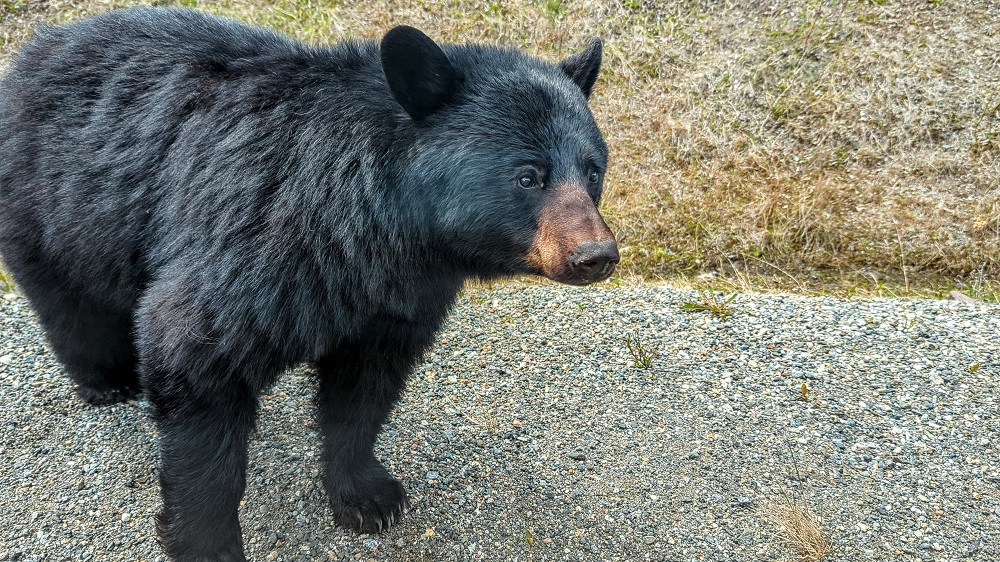
19) Buy The Milepost Book
We had several people recommend getting a copy of the Milepost book (our affiliate link). Milepost is apparently the bible for people visiting Alaska, although we didn’t end up getting a copy of it ourselves. Now that there’s so much information online, it didn’t seem quite as essential for us, but if you’re someone who prefers a physical book rather than digital information, it could be worth picking up a copy.
I imagine it’s also helpful as a reference guide when you’re driving the long stretches without any internet connection, as well as getting an even better idea of accommodation options in some of the more out-of-the-way locations.
20) Consider Driving Different Routes
There’s more than one way to get to and from Alaska, so consider going via different routes to experience more and enjoy even more scenery on your way there and back.
For example, our original plan had been to stay in Osoyoos > Kamloops > Prince George > Fort Nelson > Watson Lake > Whitehorse > Dawson City > Tok

However, wildfires meant we had to change those plans to Osoyoos > Kamloops > Prince George > New Hazelton > Jade City > Whitehorse > Dawson City > Tok
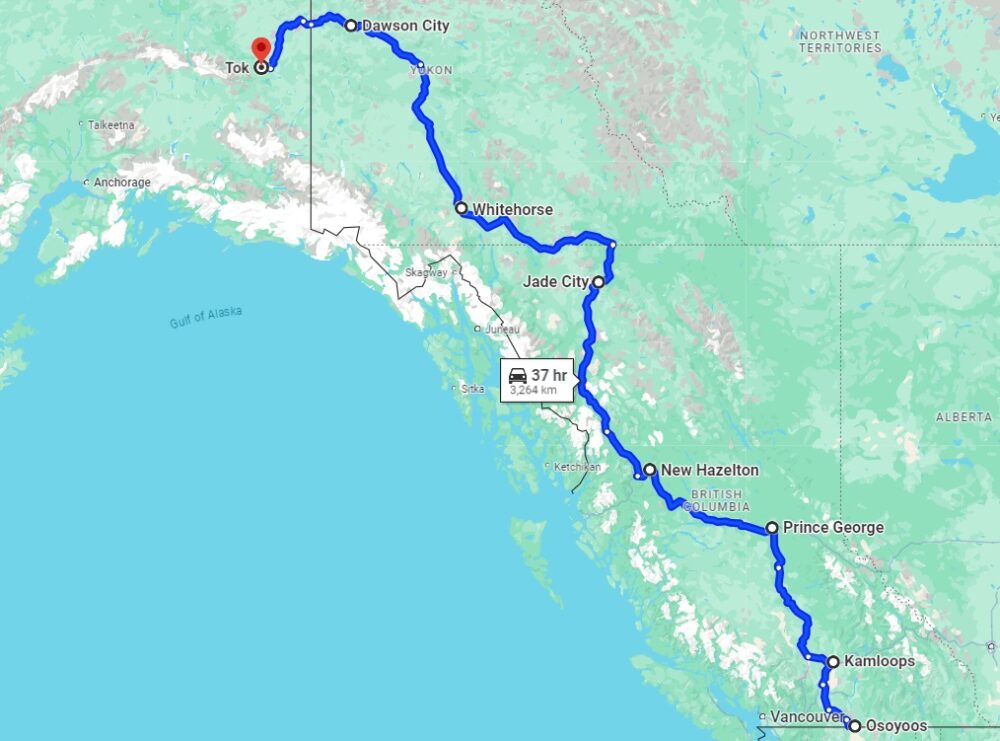
For our journey back, a fair bit of the drive was the same, but some differed: Seward > Tok > Whitehorse > Dease Lake > Stewart > Prince George > Bellingham, WA
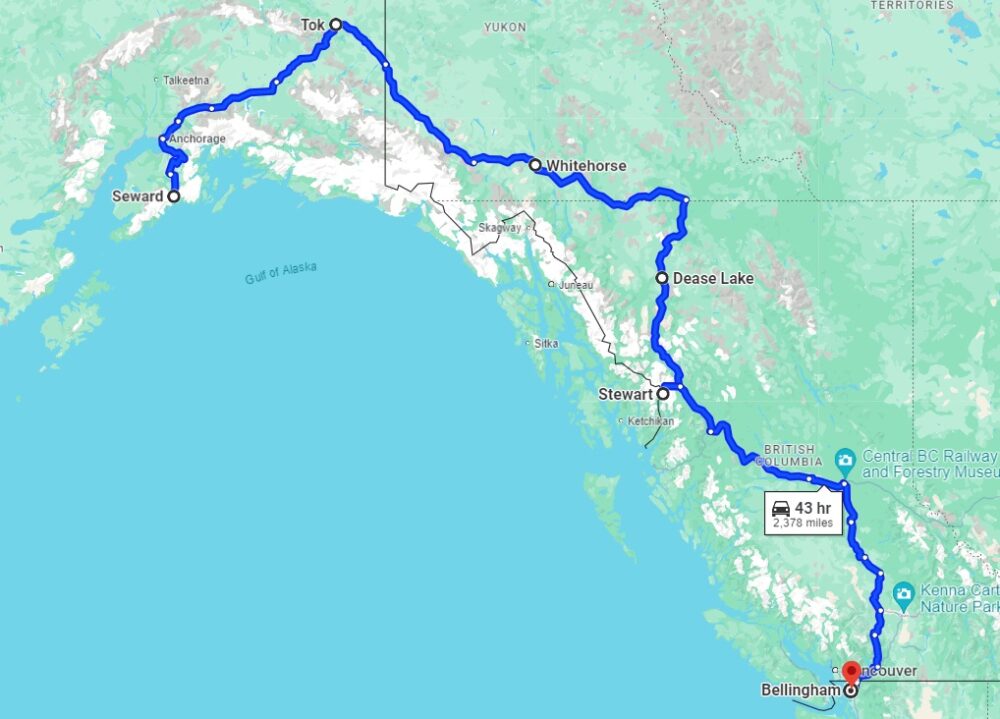
21) Take A Side Trip To Stewart
Someone recommended to us that we should take a side trip to Stewart, British Columbia which we did on our drive back down. That was a fantastic recommendation as it was one of our favorite stops – if not our favorite stop – on our drives to and from Alaska.
It’s a cute little town, the drive in to the town is stunning, it’s near Fish Creek Wildlife Observation Site in nearby Hyder, AK, there’s a delicious restaurant and Salmon Glacier is nearby.
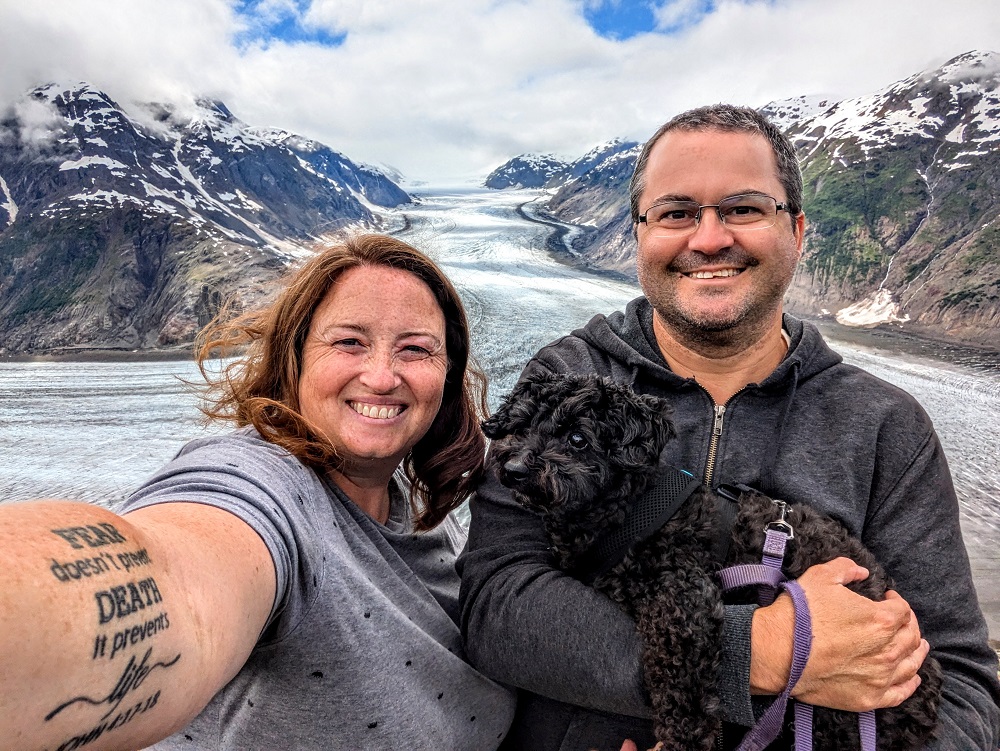
Your Tips
Those are our 21 tips for driving to Alaska, but I’m sure there’s all kinds of other good advice that could be given to people making this journey. If you have any tips for people driving to Alaska, please share them in the comments below.
[…] There are slightly different routes you can take to and from Alaska, plus lots of little towns along the way you can stop at. Here’s an account of each of our days both on the way up to Alaska and on the way back. I’ve also published a separate post with 21 tips and tricks for driving to Alaska. […]